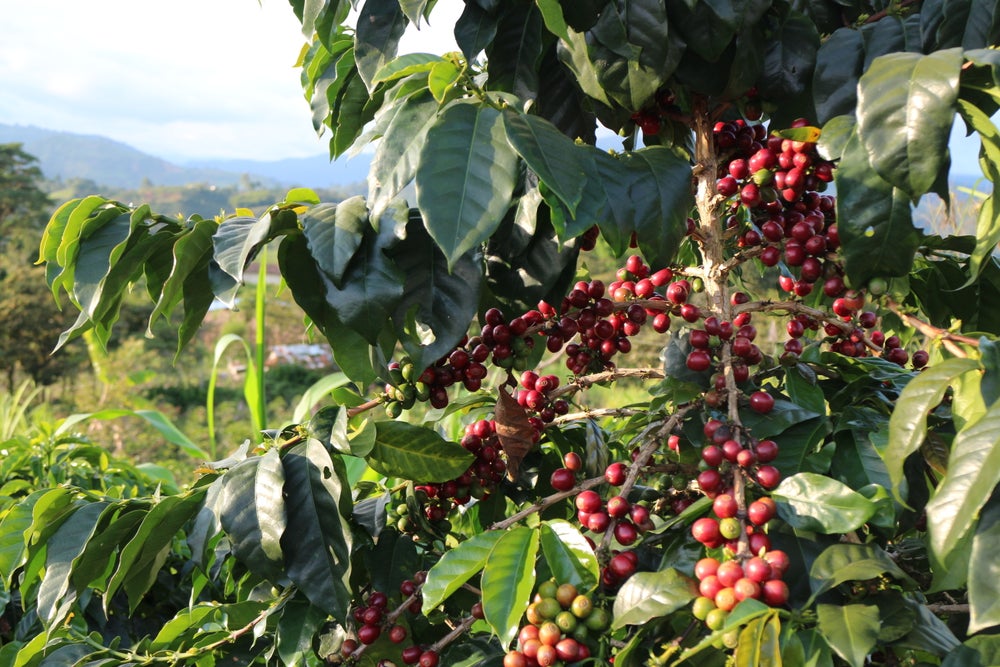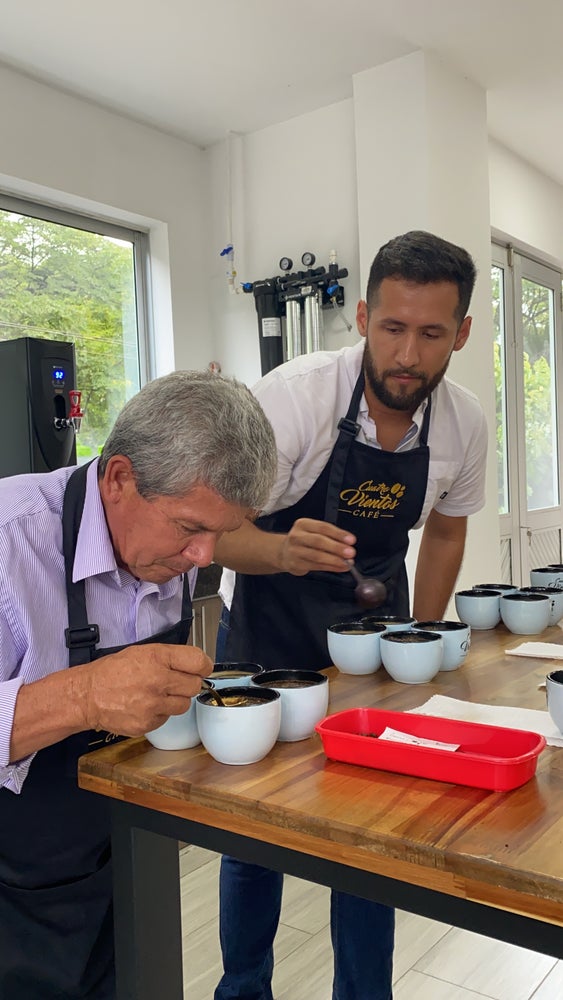About This Coffee
Husband and wife duo, Jesus and Rosa Barahona, have been cultivating coffee at Finca Quindio for more than 20 years. When they first purchased the land, a portion of the farm was used to graze cattle and another portion had Caturra planted on it. Today, they cultivate Geisha, Caturra and other varieties on their 7 hectares with an eye towards specialty production.
Jesus and his brother, Jose Espinoza, began experimenting with Natural and Anaerobic processing in 2020/2021. They have already seen the quality and the price they receive improve. Jesus and Rosa recently planted these Geisha trees to continue improving their coffee quality. We couldn’t be more pleased about how their first few harvests have turned out!
Harvest & Post-Harvest
Jesus and Rosa selectively handpick ripe, red cherry and pulp it. They ferment coffee and then wash it in clean water, Then, they lay parchment on marquesinas to sundry. They rake parchment frequently to ensure even drying.
About Geisha
Geisha (also known as Gesha) is known for its exceptional cup quality, especially when grown at high altitudes. The variety comes from Ethiopian landrace coffees and was collected from Ethiopian coffee forests in the 1930s. The name supposedly derives from Ethiopia’s Gori Gesha forest.
There is some confusion with several genetically distinct varieties that have all been called Geisha, but the most famous variety is the Panama one. The variety was brought to Lyamungu research station in Tanzania and from there to Centro Agronómico Tropical de Investigación y Enseñanza (CATIE) in Central America in 1953. At CATIE, the variety was logged as T2722. CATIE distributed T2722 across Panama in the 1960s for its Coffee Leaf Rust (CLR) resistance, but its brittle branches meant it was not widely planted.
Panama Geisha reached its modern fame in 2005 when a Geisha lot won the “Best of Panama” competition and broke contemporary records at over $20/pound. DNA analysis has demonstrated that the Panama Geisha descended from T2722 is distinct and uniform. Today, Geisha is known for its delicate florals, jasmine and stone fruit.
About Huila
The Huila region is one of the most well-known coffee growing areas of Colombia. The Department of Huila has a population of 1.125 million and is located in the southwest of the country. The capital of the department is Neiva, a city of about 380,000.
Along with Cauca and Nariño, Huila is one the three departments where the Colombian Massif is located. A massif is a group of mountain ranges and the Colombian Massif, which is known locally as Nudo de Almaguer, provides up to 70% of safe drinking and agricultural water for the Colombian population.
The Magdalena River, Colombia’s largest river, runs through the region, providing plenty of water for coffee farming and generating (directly and indirectly) up to 86% of Colombia's GDP. The mountain range also features the fertile volcanic soil so typical to the Andean Mountains.
About Cuatro Vientos
Cuatro Vientos is a family-owned exporter based in Colombia. Founded in 2018 by Julian & Yonatan Gonzalez and based in Huila, the company is named after the Gonzalez’s first farmnwhere the brothers spent much of their childhood. Yonatan and Julian learned much of what they know from their father, Armando Gonzalez who was a “pergaminero,” someone who bought and sold parchment coffee. Sucafina has worked with Cuatro Vientos since 2021.
Through their partnership with Sucafina, Cuatro Vientos is able to more effectively reach new markets. This, in turn, means they can work with more farmers and develop better programs to support their farmers.
Cuatro Vientos has 3 purchasing points in Huila: Acevedo, Santa Maria and Algeciras. These points are more than just places where they buy coffee, though. They are service hubs where farmers can access services to maintain quality and reach new markets. For Cuatro Vientos, farmers are long term partners who are focused on quality.
With these three locations, Cuatro Vientos is able to source fresh coffee year-round. In their unique position across Huila, they can tap into two alternative harvest seasons within Huila. The northern Huila harvest occurs in the first half of the year and the southern Huilaharvest happens during the second half of the year, providing high-quality coffees year round.
They also own 2 warehouses that are strategically placed in Acevedo (in Southern Huila) and Campo Alegre (in Northern Huila). The warehouses provide an array of important services to farmers. Farmers can dry their coffee, store dried parchment in silos and learn to grade and evaluate coffees in the cupping labs.
Cuatros Vientos adds value by offering logistics and milling support to the over 30 farms that they work with. These farmers are all specialty oriented and Cuatro Vientos’ focus on specialty processing helps farmers ensure that their coffees are handled properly.
One of Cuatro Vientos’ biggest impacts is their credit line offerings. Growers need financing at the beginning of the harvest and it is difficult for them to access financing through traditional banks due to a lack of financial documentation. By providing financing through their partner, Bancolombia, Cuatro Vientos is supporting long term farmer profitability. They also provide financial education workshops that increase farmers’ financial literacy and promotes overall success.
They also provide marketing services for farmers, helping them manage samples and tell their stories. Importantly, they act as an integral part of a two-way conversation between producers and roasters about what they’re looking for, what they can do and how they can best achieve the results they’re looking for.
Coffee in Colombia
Colombia has been producing and exporting coffee renowned for their full body, bright acidity and rich aftertaste, since the early 19th century.
Colombia boasts a wide range of climates and geographic conditions that, in turn, produce their own unique flavors in coffee. This also means that harvest times can vary quite a bit. In fact, between all its different regions, Colombia produces fresh crop nearly all year round.
The increasing focus on the specialty industry is changing the way traders and farmers do business. It is becoming more common for farmers to isolate the highest quality beans in their lots to market separately. These higher-quality lots are often sold under specific brands or stories.
Besides its wide variety of cup profiles, Colombia has quickly expanded its certification options over the past 10 years. The most common certifications available are Fairtrade, Rainforest Alliance, UTZ and Organic.

